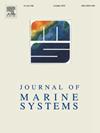Distribution and abundance of fish larvae in the Patagonian Shelf-break Front
IF 2.5
3区 地球科学
Q2 GEOSCIENCES, MULTIDISCIPLINARY
引用次数: 0
Abstract
The distribution and abundance of fish larvae were investigated in three sections across the Patagonian Shelf-break Front, in the Southwest Atlantic, between 44° and 47° S during springtime. Hydrographic sampling covered the shelf edge, slope and oceanic waters down to 3160 m depth. Larvae were collected with a Hydro-Bios Multi-net of 0.25 m2 mouth size at 48 stations. Sampling covered the outer shelf, slope and oceanic waters. Each station was sampled during day and night at five depth levels from the surface to 200 m. At each station, temperature, salinity and fluorescence profiles were obtained to characterize water masses and detect the front. The variation in salinity between shelf and Malvinas Current waters was the most obvious sign of the frontal area. Twenty-two different species belonging to 10 orders and 16 families were found. On the outer shelf, were detected larvae of Perciformes and Scorpaeniformes, in low relative abundances. The slope was characterized by the presence of larvae of Myctophiformes and Gadiformes, while in the open ocean area, larvae of mesopelagic fishes such as Myctophiformes, Argentiniformes and Stomiiformes predominated. The highest abundance of larvae was found at the levels closest to the surface in the night stations. This study is the first one to obtain information on the ichthyoplankton composition of the Patagonian Shelf-break Front ecosystem for the austral spring period.
巴塔哥尼亚冰架断裂锋鱼类幼鱼的分布和丰度
研究了西南大西洋44°~ 47°S之间的巴塔哥尼亚断裂带锋3个断面春季鱼类幼虫的分布和丰度。水文采样覆盖了陆架边缘、斜坡和深达3160米的海洋水域。采用0.25 m2口型的Hydro-Bios Multi-net在48个站点采集幼虫。采样范围包括外大陆架、斜坡和海水。每个站点在白天和夜间从地表到200米的五个深度进行采样。在每个站点,获得温度、盐度和荧光剖面,以表征水团并检测锋面。陆架和马尔维纳斯洋流之间盐度的变化是锋面区最明显的标志。共发现16科10目22种。外大陆架上检出有表现目和Scorpaeniformes幼虫,相对丰度较低。坡面以霉形目和加底形目的幼虫为主,而开阔海域以霉形目、阿根廷形目和气孔形目等中远洋鱼类的幼虫为主。夜间站点中最接近地表的水平面幼虫丰度最高。本研究首次获得了南部春季巴塔哥尼亚冰架断裂锋生态系统的浮游鱼类组成信息。
本文章由计算机程序翻译,如有差异,请以英文原文为准。
求助全文
约1分钟内获得全文
求助全文
来源期刊

Journal of Marine Systems
地学-地球科学综合
CiteScore
6.20
自引率
3.60%
发文量
81
审稿时长
6 months
期刊介绍:
The Journal of Marine Systems provides a medium for interdisciplinary exchange between physical, chemical and biological oceanographers and marine geologists. The journal welcomes original research papers and review articles. Preference will be given to interdisciplinary approaches to marine systems.
 求助内容:
求助内容: 应助结果提醒方式:
应助结果提醒方式:


